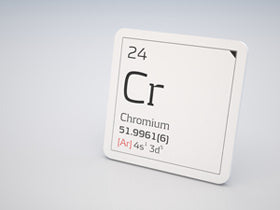What is Chromium and how is it used?
Chromium is a metal found in natural deposits as ores containing other elements. The greatest use of chromium is in metal alloys such as stainless steel; protective coatings on metal; magnetic tapes; and pigments for paints, cement, paper, rubber, composition floor covering, and other materials. Its soluble forms are used in wood preservatives.

Why is Chromium being regulated?
In 1974, Congress passed the Safe Drinking Water Act. This law requires EPA to determine safe levels of chemicals in drinking water that do or may cause health problems. These non-enforceable levels, based solely on possible health risks and exposure, are called Maximum Contaminant Level Goals.
The MCLG for chromium has been set at 0.1 parts per million (ppm) because EPA believes this level of protection would not cause any of the potential health problems described below.
Based on this MCLG, EPA has set an enforceable standard called a Maximum Contaminant Level (MCL). MCLs are set as close to the MCLGs as possible, considering the ability of public water systems to detect and remove contaminants using suitable treatment technologies.
The MCL has also been set at 0.1 ppm because EPA believes, given present technology and resources, this is the lowest level to which water systems can reasonably be required to remove this contaminant should it occur in drinking water.
These drinking water standards and the regulations for ensuring these standards are met, are called National Primary Drinking Water Regulations. All public water supplies must abide by these regulations.
What are the health effects?
Short-term: EPA has found chromium to potentially cause the following health effects when people are exposed to it at levels above the MCL for relatively short periods of time: skin irritation or ulceration.
Long-term: Chromium has the potential to cause the following effects from a lifetime exposure at levels above the MCL: damage to the liver, kidney circulatory, and nerve tissues; skin irritation.
How much Chromium is produced and released to the Environment?
Production of the most water-soluble forms of chromium, chromate, and dichromates, was in the range of 250,000 tons in 1992. Though chromium occurs in nature mostly as chrome iron ore and is widely found in soils and plants, it is rare in natural waters. The two largest sources of chromium emission in the atmosphere are from the chemical manufacturing industry and the combustion of natural gas, oil, and coal.
From 1987 to 1993, according to the Toxics Release Inventory, chromium compound releases to land and water totaled nearly 200 million pounds. These releases were primarily from industrial organic chemical industries. The largest releases occurred in Texas and North Carolina. The largest direct releases to water occurred in Georgia and Pennsylvania.
What happens to Chromium when it is released to the environment?
When released to land, chromium compounds bind to soil are not likely to migrate to ground water. They are very persistent in water as sediments. There is a high potential for the accumulation of chromium in aquatic life.
How will Chromium be detected in and removed from my drinking water?
The regulation for chromium became effective in 1992. Between 1993 and 1995, EPA required your water supplier to collect water samples once and analyze them to find out if chromium is present above 0.1 ppm. If it is present above this level, the system must continue to monitor this contaminant every 3 months.
If contaminant levels are found to be consistently above the MCL, your water supplier must take steps to reduce the amount of chromium so that it is consistently below that level. The following treatment methods have been approved by EPA for removing chromium: Coagulation/Filtration, Ion Exchange, Reverse Osmosis, Lime Softening.
How will I know if Chromium is in my drinking water?
If the levels of chromium exceed the MCL, the system must notify the public via newspapers, radio, TV, and other means. Additional actions, such as providing alternative drinking water supplies, may be required to prevent serious risks to public health.
This is a factsheet about a chemical that may be found in some public or private drinking water supplies. It may cause health problems if found in amounts greater than the health standard set by the United States Environmental Protection Agency (EPA).
Drinking Water Standards:
- MCLG: 0.1 ppm
- MCL: 0.1 ppm
Chromium Releases to Water and Land, 1987 to 1993 (in pounds):
| Water | Land | |
|---|---|---|
| TOTALS | 2,876,055 | 196,880,624 |
| Top Ten States * | ||
|---|---|---|
| TX | 102,079 | 64,301,920 |
| NC | 43,522 | 55,217,044 |
| IN | 85,570 | 15,955,895 |
| OH | 51,830 | 8,319,600 |
| UT | 1,750 | 5,817,015 |
| AR | 2,300 | 3,532,000 |
| KY | 255 | 2,491,519 |
| PA | 110,149 | 2,337,905 |
| GA | 679,721 | 1,404,698 |
| ID | 91,750 | 1,404,870 |
| Major Industries* | ||
|---|---|---|
| Indust. organics | 3,272 | 120,707,814 |
| Steelworks, Blast furn. | 609,174 | 16,638,880 |
| Electrometallurgy | 33,269 | 10,796,928 |
| Copper smelting, refining | 1,750 | 5,817,015 |
| Nonferrous smelting | 2,300 | 3,532,000 |
| Inorganic pigments | 88,721 | 1,375,700 |
| Pulp mills | 985,800 | 224,198 |
EPA National Primary Drinking Water Regulations



